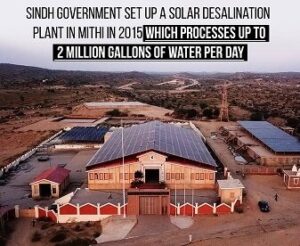 The people of rural and remote areas of Sindh, have witnessed a transformative shift toward the use of solar power for operating tubewells and powering households due to unaffordable power tariff.
The people of rural and remote areas of Sindh, have witnessed a transformative shift toward the use of solar power for operating tubewells and powering households due to unaffordable power tariff.
This change is largely driven by the declining reliability and affordability of traditional electricity sources, coupled with rising costs and frequent load shedding. As rural communities have faced growing challenges related to energy access, solar power has emerged as a viable, cost-effective, and sustainable solution, with profound implications for both agriculture and household energy consumption.
Agriculture is the backbone of Sindh’s economy, and the availability of water for irrigation is critical. Traditionally, water pumps and tubewells powered by grid electricity or diesel generators were commonly used. However, rising electricity costs and the erratic supply of electricity have made these traditional options increasingly untenable. Frequent and prolonged power outages disrupt farming operations, delay irrigation schedules, and negatively impact crop yields. Diesel-powered tubewells, while offering an alternative, have proven costly due to fluctuating fuel prices and high operating and maintenance expenses. The unreliability and expense of traditional energy sources have made it difficult for many small-scale farmers to remain competitive.
Solar-powered tubewells, on the other hand, provide a highly efficient solution for rural farmers. By harnessing the abundant sunlight that Sindh receives throughout the year, solar energy offers an uninterrupted and sustainable power source. Once installed, solar panels have low operating costs and minimal maintenance requirements. Farmers can use solar-powered tubewells to draw water as needed, ensuring timely irrigation and better crop management. Moreover, by reducing dependency on grid electricity and diesel, farmers achieve significant cost savings over time, improving their profitability and financial stability.
The move toward solar energy is not limited to agricultural operations alone; rural households in Sindh are also increasingly embracing solar power as a solution for their daily energy needs. The unreliability of the electricity supply, coupled with frequent load shedding, has made life challenging for residents who rely on electricity for basic tasks such as lighting, cooling, and appliance use. The transition to solar-powered home systems has empowered many families to access reliable electricity for the first time. Small-scale solar home systems can provide lighting, charge mobile phones, and power small appliances, significantly improving the quality of life for rural residents.
The government, private sector, and international development organizations have played a role in promoting the adoption of solar technology in Sindh. Subsidies, grants, and microfinancing options have helped reduce the upfront costs of solar installations, making them more accessible to low-income households and farmers. Non-governmental organizations (NGOs) have also been active in educating communities about the benefits of solar energy, providing training in the installation and maintenance of solar systems, and facilitating the spread of this technology across rural areas.
The environmental benefits of solar energy adoption are noteworthy as well. By reducing dependence on fossil fuels and grid electricity, rural communities are contributing to the reduction of greenhouse gas emissions and the mitigation of climate change impacts. This shift to renewable energy aligns with global efforts to promote sustainable development and transition to cleaner energy sources.
While the adoption of solar power is transforming rural Sindh, challenges remain. The initial cost of installing solar panels can still be prohibitive for some farmers and families, despite available subsidies and financing options. Ensuring long-term maintenance and addressing technical issues require continued training and support for users. Nevertheless, the growing adoption of solar energy signals a positive and hopeful trend in the region’s energy landscape, offering a sustainable path forward for rural communities in Sindh.
